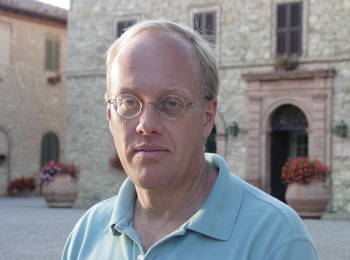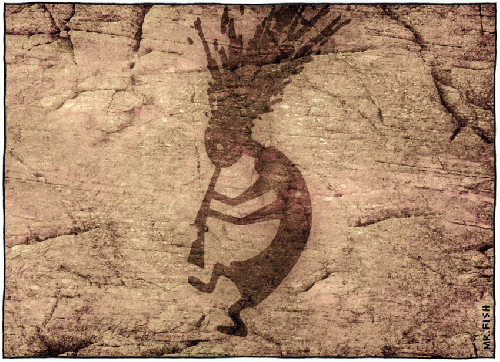From Truthdig
CHACO CULTURE NATIONAL HISTORICAL PARK, N.M. -- A bitter wind whipped down the 10-mile-long Chaco Canyon, kicking up swirls of dust among the thorny greasewood and sagebrush bushes. I ducked behind one of the towering sandstone walls in the three-acre ruin, or Great House, known as Pueblo Bonito, to escape the gusts. I was in the section of the 800-room complex where burials took place.
Treasure hunters and archaeologists have uncovered in these ruins and tombs delicate white-and-black painted ceramics, flutes, ceremonial sticks, tiny copper bells, inlaid bone, macaw and parrot skeletons, cylindrical jars with the residue of chocolate that would have been imported from Mexico, shells and intricate turquoise jewelry and sculptures. From this vast, bureaucratic and ceremonial complex, the Anasazi -- a Navajo word meaning ancient ones or possibly ancient enemies -- dominated the Southwest from about the year 850 until the society collapsed in about 1150.
The Chaco ruin, 6,200 feet above sea level, is one of the largest and most spectacular archaeological sites in North America. It is an impressive array of 15 interconnected complexes, each of which once had four-to-five-story stone buildings with hundreds of rooms each. Seven-hundred-pound wooden beams, many 16 feet long, were used in the roofs. Huge circular, ceremonial kivas -- religious centers dug into the earth, with low masonry benches around the base of the room to accommodate hundreds of worshippers -- dot the ruins. It rivals the temples and places built by the Aztecs and the Mayans.
Radiating from Chaco is a massive 400-mile network of roads, some 30 feet wide and still visible in the haunting desert landscape, along with dams, canals and reservoirs to collect and store rainwater. The study of astronomy, as with the Aztec and the Maya, was advanced. Petroglyphs and pictographs on the canyon walls often record astrological and solar events. One pictograph shows a hand, a crescent moon and a 10-pointed star that is believed to depict a 1054 supernova, and one of the petroglyphs appears to represent a solar eclipse that occurred in 1097.
A few thousand priests and ruling elites, along their retainers and administrators, lived in the Great Houses or palaces. They oversaw the trade routes that stretched to the California coast and into Central America. They maintained the elaborate network of lighthouses whose signal fires provided rapid communication. They built the roads, the long flights of stairs carved into the rock formations, the bridges, the wooden ladders to scale the towering cliffs, and the astronomical observatories that meticulously charted the solar observations to determine the equinoxes and solstices for planting and harvesting and for the annual religious festivals when thousands, perhaps tens of thousands, would gather. The buildings in the complexes were oriented to solstitial or cardinal points, a difference the anthropologist Stephen H. Lekson believes denoted not only competing cosmologies but competing political ideologies.
"Chaco was the political capital of a well-defined region that encompassed most of the Four Corners country, with more than 150 outlying Great Houses scattered over an area about the size of Ireland," Lekson writes.
But this complex society, like all complex societies, proved fragile and impermanent. It fell into precipitous decline after nearly three centuries. The dense forests of oak, pià �on and ponderosa pines and juniper that surrounded the canyon were razed for construction and fuel. The soil eroded. Game was hunted to near-extinction. The diet shifted in the final years from deer and turkey to rabbits and finally mice. Headless mice in the late period have been found by archaeologists in human coprolites -- preserved dry feces. The Anasazi's open society, one where violence was apparently rare, where the people moved unhindered over the network of well-maintained roads, where warfare was apparently absent, where the houses of the rich and powerful were not walled off, where the population shared in the spoils of empire, was replaced with the equivalent of gated, fortified compounds for the elites and misery, hunger, insecurity and tyranny for the commoners.
Dwellings began to be built in the cliffs, along with hilltop fortresses, although these residences were not close to the fields and water supply. Defensive walls were constructed along with moats and towers. The large, public religious ceremonies that once united the culture and gave it cohesion fractured, and tiny, warring religious cults took over, the archaeologist Lynne Sebastian notes.
Lekson, a professor of anthropology at the University of Colorado in Boulder, believes the Anasazi rulers during the decline increasingly resorted to savage violence and terror, including the public executions of dissidents and rebels. He finds evidence, much of it documented in Steven A. LeBlanc's book "Prehistoric Warfare in the American Southwest," that "Chaco death squads" were sent out across the empire. LeBlanc writes that at Yucca House, a Chaco Great House near Mesa Verde, as many as 90 people were killed and tossed into a kiva and at least 25 showed signs of mutilation.
"Chacoan violence, concentrated and brutal, appears to represent government terror: the enforcement of Chaco's rule by institutionalized force," Lekson writes in the article "Chaco Death Squads" in Archeology magazine. "Violence was public, intended to appall and subdue the populace. Chacoan death squads (my term, not LeBlanc's) executed and mutilated those judged to be threats to Chacoan power, those who broke the rules."
The anthropologist Christy G. Turner, who specialized in osteology, the study of human bones, in his book "Man Corn" cited "cannibalism and human sacrifice as conspicuous elements of terrorism." In short, as Lekson writes, "the death squad killed you, cut you up, and then ate you in front of your relatives and neighbors." The term "man corn" comes from the Nahuatl word "tlacatlaolli," which Turner defined as a "sacred meal of sacrificed human meat, cooked with corn." Debra Martin goes on to argue in a paper titled "Violence Against Women in the La Plata River Valley, A.D. 1000-1300" (located on the periphery of the Chacoan empire) that there is evidence of battered women who were perhaps slaves.
The Anasazi elites, no longer willing or able to provide social services or competent governance and plagued by shortages of natural resources, kept extracting unsustainable tribute. They resorted to harsher and harsher forms of repression. By the end, they were hated. The civilization suffered a severe drought in the year 1130. It was the final blow. The impressive structures would lie abandoned until they were discovered by the nomadic Navajos some 600 years later. The Navajos did not reoccupy the buildings, many of which contained skeletal remains, because they believed them to be filled with evil spirits.
"Parts of Chacoan society were already in deep trouble after 1050 as health and living conditions progressively eroded in the southern districts' open farming communities," David E. Stuart writes in his book "Anasazi America." "The small farmers in the south had first created reliable surpluses to be stored in the great houses. Ultimately, it was the increasingly terrible living conditions of those farmers, the people who grew the corn, that had made Chacoan society so fatally vulnerable. The farmers simply got too little back from their efforts to carry on. Thus, great-house society emphasized other trade partners and supported new, lower-cost suppliers on its northern tier. This final trade network likely was focused on the continued well-being of the elites rather than the general welfare of its regional society."
As the economic and social situation deteriorated, the elites accelerated the building of roads and Great Houses. They held more elaborate rituals and built more kivas. This is typical of decaying societies. The great Mayan city of Tikal was constructed over a period of 1,500 years, but its most impressive temples and towers were erected during its final century. These grandiose projects and spectacles were meant to project power and immortality. They exacerbated, however, the suffering of the impoverished farmers and workers and the decline of diminishing natural resources.
(Note: You can view every article as one long page if you sign up as an Advocate Member, or higher).






